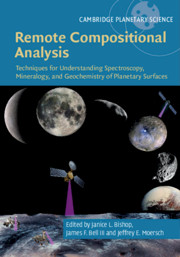 Remote Compositional Analysis
Remote Compositional Analysis Laboratory Spectra of Geologic Materials
from Part I - Theory of Remote Compositional Analysis Techniques and Laboratory Measurements
Published online by Cambridge University Press: 15 November 2019
Visible/near-infrared (VNIR) reflectance spectra are used in laboratory, field, and airborne studies to characterize geologic materials. This chapter covers the region 0.3–5 µm and describes the species responsible for the absorption of radiation at specific wavelengths that create spectral features used to identify minerals, rocks, and other geologic materials. Fe contributes greatly to VNIR spectral signatures, producing features near 1 and 2 µm for Fe2+ in spectra of pyroxene and glass, while a broad, strong band from ~0.9 to 1.3 µm is characteristic of Fe2+ in olivine, carbonate, and many sulfates; a weak band near 1.2 µm is due to Fe2+ in feldspar; and bands near 0.6 and 0.9 µm arise from Fe3+ in ferric oxides/hydroxides. Water bands occur near 0.96, 1.15, 1.4, 1.9, and 2.9 µm, depending on the mineral structure, while structural OH bands occur near 1.4, 2.1–2.5, and 2.7 µm. Additional features are observed for carbonates, nitrates, sulfates, phosphates, chlorides, and perchlorates. The spectral signatures of geologic samples are also affected by how photons interact with particles in the sample. Factors such as grain size, coatings and mixtures influence the reflectance, transmittance, and absorption of photons at grain boundaries and contribute to the VNIR spectral properties of geologic materials.
To save this book to your Kindle, first ensure [email protected] is added to your Approved Personal Document E-mail List under your Personal Document Settings on the Manage Your Content and Devices page of your Amazon account. Then enter the ‘name’ part of your Kindle email address below. Find out more about saving to your Kindle.
Note you can select to save to either the @free.kindle.com or @kindle.com variations. ‘@free.kindle.com’ emails are free but can only be saved to your device when it is connected to wi-fi. ‘@kindle.com’ emails can be delivered even when you are not connected to wi-fi, but note that service fees apply.
Find out more about the Kindle Personal Document Service.
To save content items to your account, please confirm that you agree to abide by our usage policies. If this is the first time you use this feature, you will be asked to authorise Cambridge Core to connect with your account. Find out more about saving content to Dropbox.
To save content items to your account, please confirm that you agree to abide by our usage policies. If this is the first time you use this feature, you will be asked to authorise Cambridge Core to connect with your account. Find out more about saving content to Google Drive.